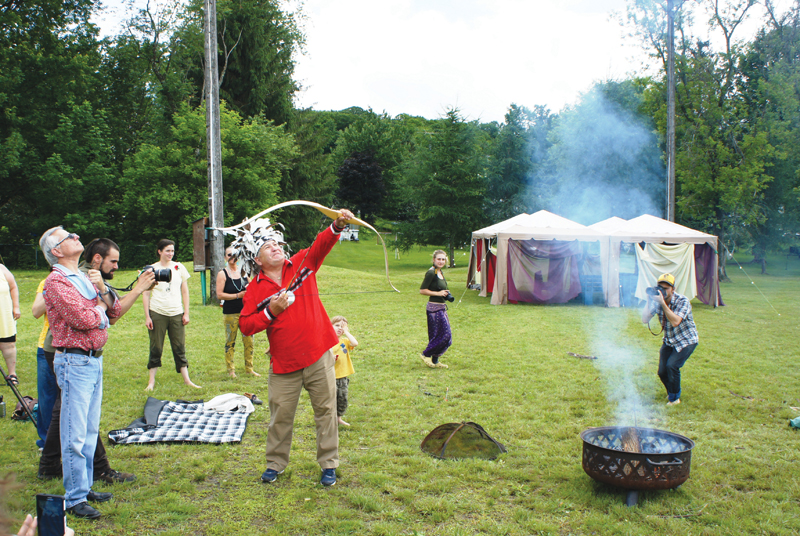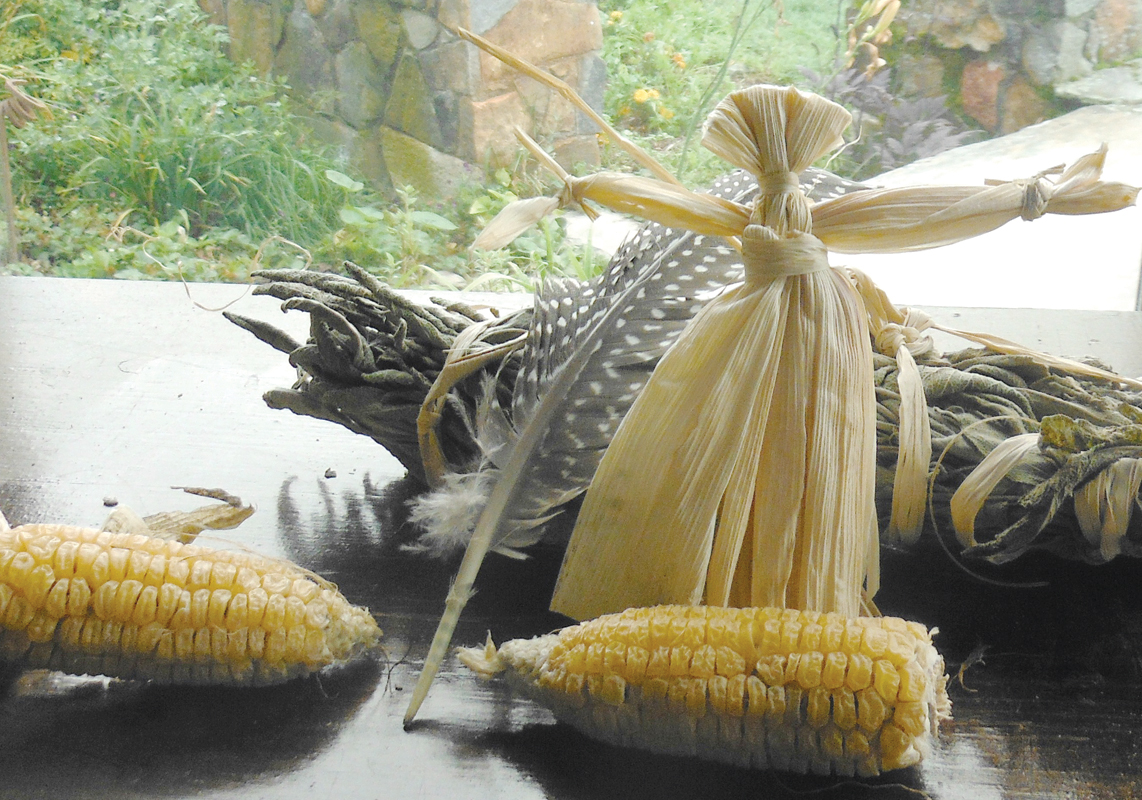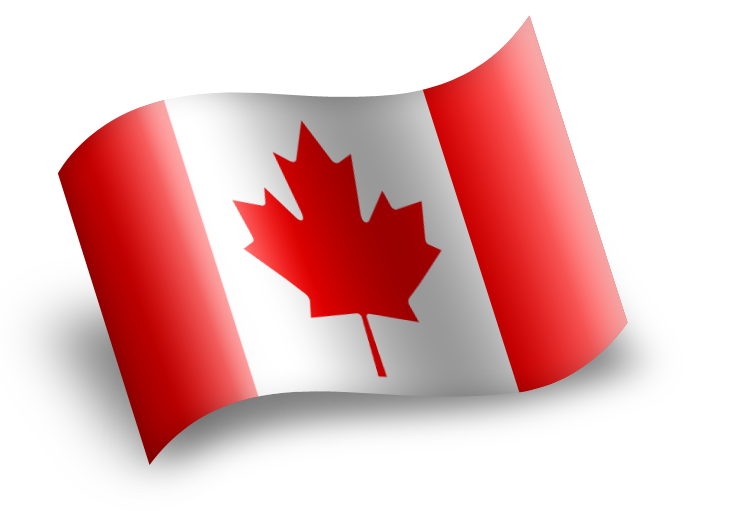by Frederick Wiseman
Working in the garden has helped me conquer my fears and be one with the Earth and our ancestors. I talk and sing to the gardens while I’m weeding, watering or just checking on them.
I not only help them grow and feel appreciated, I also feel the ancestors with me. What I’m doing feels right and makes me proud. – Holly LaFrance, Kikawinno (Field-maker), Missisquoi Abenaki
Backstory
 Indigenous gardening is more than a Three Sister’s garden or a Green Corn Ceremony. It is a way of life that defines a person’s identity, health and home. The Wabanaki people, the People of the Dawn, have suffered 400 years of atrocities from disease, war, genocide and oppression, but there are still those threads of ancestral seed, field and farmer connections that have persisted despite all of this historical trauma. Indigenous gardening is more than a Three Sister’s garden or a Green Corn Ceremony. It is a way of life that defines a person’s identity, health and home. The Wabanaki people, the People of the Dawn, have suffered 400 years of atrocities from disease, war, genocide and oppression, but there are still those threads of ancestral seed, field and farmer connections that have persisted despite all of this historical trauma.
Three pivotal events led to the repair of this almost-severed connection. In 2007, an unknown corn cultivar was restored to the Koas Abenaki people of the upper Connecticut River Valley by a family who had cherished it since the late 1700s. Two years later, Nulhegan Abenaki Chief Luke Willard shared his family’s ancestral upland conical mound and floodplain linear mound agro-engineering systems for his tribe’s state recognition documentation. In November of 2012, Haudenosaunee seed- and traditions-keeper Steve McComber shared seven Abenaki cultivars known to his people that needed rematriation with his eastern neighbors.
Immediately, these tiny leads connecting back to an almost forgotten garden world were explored and consolidated by the Seeds of Renewal Project under my supervision. New cultivars arrived in seed-collection jars from cold hill farms of Vermont, tiny multi-ethnic villages on the south shore of the Gulf of St. Lawrence and professional Native American seed preservationists from Alberta to Colorado. In 2013, the plants began to teach us ancestral botanical knowledge. We discovered that Morrisville sunflowers made perfect trellises for Norridgewock beans that had smothered three-foot-high Koas corn, and that tall plants did not like the Nulhegan-style floodplain planting mounds. We took the Green Corn song, Rain Dance, Four Directions chant and Sun Dance from the world of modern pow-wow performances and recontextualized them in their original setting and purpose.
 In 2014, elders, knowing that we were on a good path, began sharing fragments of lost ancient horticultural ceremonies. First came the New Year’s Forgiveness Moon, which correlated the solar and lunar calendars. Then came teachings around the Harvest Dinner and Green Corn Dance. In 2016, an obscure, out-of-print Abenaki cookbook with recipes from elders long passed was discovered. In 2019, the Shooting Fire Solstice Ceremony was restored. Lapsed Abenaki names for crop, field, pest, nurture and ceremony were rediscovered from the pages of the Western Abenaki Dictionary and from traditional songs and restored to their own place, time and ecology. In a series of magical moments, we effortlessly learned from our elders and the plants themselves, thereby completing the first endeavour of an ancestral Abenaki Food System. In 2014, elders, knowing that we were on a good path, began sharing fragments of lost ancient horticultural ceremonies. First came the New Year’s Forgiveness Moon, which correlated the solar and lunar calendars. Then came teachings around the Harvest Dinner and Green Corn Dance. In 2016, an obscure, out-of-print Abenaki cookbook with recipes from elders long passed was discovered. In 2019, the Shooting Fire Solstice Ceremony was restored. Lapsed Abenaki names for crop, field, pest, nurture and ceremony were rediscovered from the pages of the Western Abenaki Dictionary and from traditional songs and restored to their own place, time and ecology. In a series of magical moments, we effortlessly learned from our elders and the plants themselves, thereby completing the first endeavour of an ancestral Abenaki Food System.
Thoughtful Ancestral Care
By 2018, the Vermont Abenaki community had enough fragments of their lost garden culture in hand to begin a noble experiment in biocultural restoration. We reunited Abenaki people, plants and ceremony as best we could and let them intermingle through the cycles and seasons of Sun and Moon.
 Fields were opened at the Vermont Indigenous Heritage Center, the Intervale Center, and the University of Vermont Horticultural Farm in Burlington, Vermont. These fields were blessed with ancestral Abenaki ceremony and planted with ancestral Abenaki cultivars, by or under the direction of Abenaki gardeners. They were nurtured by Sun and ceremony and later harvested with Abenaki-made tools and baskets. Fields were opened at the Vermont Indigenous Heritage Center, the Intervale Center, and the University of Vermont Horticultural Farm in Burlington, Vermont. These fields were blessed with ancestral Abenaki ceremony and planted with ancestral Abenaki cultivars, by or under the direction of Abenaki gardeners. They were nurtured by Sun and ceremony and later harvested with Abenaki-made tools and baskets.
The plants either grew like weeds or stubbornly refused to grow, depending on the type of field, soil and fertilizer. We learned the value of fish fertilizer for the corn, the proper spacing of the mounds to allow for the enormous East Montpelier squash vines, and exactly when the Calais corn was ripe enough for the Green Corn Ceremony. We saw ecology at its best–Hardwick ground cherries prevented Japanese beetles from attacking the strangely susceptible Norridgewock beans.
Abenaki field-makers, including Holly, began to recapture ancestral wisdom from the memory encoded in the plants, soils and seasons.
Restoration of Wonder
The gardens were outside the rhythm of modern life. Their environmental and calendrical demands were simple, primal and direct: Care for us or you will fail your responsibility. As the growing plants taught field-makers to observe infinite nuances of growth, disease and growing conditions, the healing Indigenous eye, ear and heart slowly became aware of the wonders in and around the restored fields.
Eagles and ospreys, rarely seen in the Winooski River Valley, began doing routine flyovers. Sounds at the edge of hearing with wisps of mist and shadow in the corner of the eye and the fleeting aroma of long-extinct campfires made almost daily appearances. Indigenous people visiting from out west felt like they were at home in a faraway land. We do not know where the enchantment lay–in land, spirit, subconscious or heightened awareness of the seemingly mundane.
Restoration of Health
As wonder became normal and awe became routine, a heretofore mysterious balance was restored in that tiny evolving biocultural ecosystem in the Winooski Valley to the east of The Lake Between, now known as Lake Champlain. The most obvious effect was a reversal of yet unknown depth and breadth of the effects of centuries of intergenerational trauma, identity confusion and cultural loss.
Kikawinno Holly LaFrance says it best: …I didn’t know my heritage, customs or who I am. I was depressed and stressed. I’m coming out of my shell, by drumming and singing. I not only have hardly any stress, but my panic attacks are few and far between. I sleep better and no longer wake up with night terrors. I greet each day with a smile, smudge and thank the Creator for another day. I’m connected to the land in a good way. I used to be ashamed of who I am, now I’m proud.
Fred Wiseman is a paleoecologist who authored Seven Sisters, published by Earth Haven Learning Centre. This book shares his discovery of ancient seeds and food systems of the Wabinaki people and the Chesapeake Bay region in eastern North America.
|


![]()

 Indigenous gardening is more than a Three Sister’s garden or a Green Corn Ceremony. It is a way of life that defines a person’s identity, health and home. The Wabanaki people, the People of the Dawn, have suffered 400 years of atrocities from disease, war, genocide and oppression, but there are still those threads of ancestral seed, field and farmer connections that have persisted despite all of this historical trauma.
Indigenous gardening is more than a Three Sister’s garden or a Green Corn Ceremony. It is a way of life that defines a person’s identity, health and home. The Wabanaki people, the People of the Dawn, have suffered 400 years of atrocities from disease, war, genocide and oppression, but there are still those threads of ancestral seed, field and farmer connections that have persisted despite all of this historical trauma.  In 2014, elders, knowing that we were on a good path, began sharing fragments of lost ancient horticultural ceremonies. First came the New Year’s Forgiveness Moon, which correlated the solar and lunar calendars. Then came teachings around the Harvest Dinner and Green Corn Dance. In 2016, an obscure, out-of-print Abenaki cookbook with recipes from elders long passed was discovered. In 2019, the Shooting Fire Solstice Ceremony was restored. Lapsed Abenaki names for crop, field, pest, nurture and ceremony were rediscovered from the pages of the Western Abenaki Dictionary and from traditional songs and restored to their own place, time and ecology. In a series of magical moments, we effortlessly learned from our elders and the plants themselves, thereby completing the first endeavour of an ancestral Abenaki Food System.
In 2014, elders, knowing that we were on a good path, began sharing fragments of lost ancient horticultural ceremonies. First came the New Year’s Forgiveness Moon, which correlated the solar and lunar calendars. Then came teachings around the Harvest Dinner and Green Corn Dance. In 2016, an obscure, out-of-print Abenaki cookbook with recipes from elders long passed was discovered. In 2019, the Shooting Fire Solstice Ceremony was restored. Lapsed Abenaki names for crop, field, pest, nurture and ceremony were rediscovered from the pages of the Western Abenaki Dictionary and from traditional songs and restored to their own place, time and ecology. In a series of magical moments, we effortlessly learned from our elders and the plants themselves, thereby completing the first endeavour of an ancestral Abenaki Food System.  Fields were opened at the Vermont Indigenous Heritage Center, the Intervale Center, and the University of Vermont Horticultural Farm in Burlington, Vermont. These fields were blessed with ancestral Abenaki ceremony and planted with ancestral Abenaki cultivars, by or under the direction of Abenaki gardeners. They were nurtured by Sun and ceremony and later harvested with Abenaki-made tools and baskets.
Fields were opened at the Vermont Indigenous Heritage Center, the Intervale Center, and the University of Vermont Horticultural Farm in Burlington, Vermont. These fields were blessed with ancestral Abenaki ceremony and planted with ancestral Abenaki cultivars, by or under the direction of Abenaki gardeners. They were nurtured by Sun and ceremony and later harvested with Abenaki-made tools and baskets.